So, when it comes to family SUV’s, two of the most popular offerings for years have been the Toyota Highlander and Honda Pilot. But over time the demand for more space has grown, and the crossovers in this segment have been getting larger to meet that demand. The just-redesigned Pilot is one of those enlarged models, however, Toyota has gone a different route and introduced a totally new product called the Grand Highlander. As the name implies, this is a larger SUV, but it’s also grand in several other ways as well. So, how does the Grand Highlander vs Pilot battle play out? Keep reading to find out!
Pricing and Equipment
First off, let’s quickly establish the pricing and trim levels right from the start.
Starting with the all-new Honda Pilot, we have the Elite trim, which is now the top model since there is no longer a Black Edition. After the destination charge, the total rings in at $53,725.
Pilot Elite AWD: $52,380 | Options: +$0 | Destination: $1,345 | Total: $53,725
Now moving on to the all-new Grand Highlander, because its available in a lot more versions than the Pilot, the price can also be grander. The very top version is almost 60,000, so for this comparison we picked the Limited Hybrid Max which is much closer to the Pilot’s price tag. With this 2nd-from-the-top model, we have a price tag of $55,800.
GH Limited Hybrid Max AWD: $54,040 | Options: +$425 | Destination: $1,335 | Total: $55,800
Now this is going to be an objective comparison. We have done our best to weigh the points awarded throughout in major and minor categories, but at the end of the comparison we will sum up with our thoughts and revisit the price difference for a value assessment. With that being said, let’s get into this comparison!
Exterior Design
When you first walk up to both these models, you will immediately notice the latest trend towards making family crossovers look tougher and boxier. With the redesign, Honda moved back towards the looks of the 2nd generation model, and Toyota has certainly established a totally distinct look from the sleek regular Highlander.
Both models have chrome strips across the top that connect the grilles into the headlights, and speaking of lighting, we have LED headlights and fog lamps on both models. The only difference worth mentioning is that the Grand Highlander’s are the more premium projector style instead of reflector.
Moving to the side, the Pilot previously had a big advantage in size over the Highlander but not so with this Grand Highlander. It is a completely distinct product, and it leapfrogs over even the large Pilot by an inch and a half. This makes it one of the largest options in the entire class, which is going to be important later in the comparison when we get to the third rows and cargo areas.
Length: 199.9-inches (Pilot) | 201.4-inches (Highlander)
Design-wise we have 20-inch alloy wheels, and the boxy designs continue to the backs as well. As far as the actual features, they are very similar with exposed wipers, exposed exhaust tips and black accents between the taillights. Speaking of those, all 3 elements are LED on the Toyota, while the reverse light and turn signals are incandescent on the Honda.
Both can tow up to 5,000 lbs.
Towing (max): Grand Highlander: 5,000 lbs | Pilot: 5,000 lbs
Additional Features
Now, checking out some of the individual features, both of their mirrors have heating, blind spot monitoring, power-folding and projector puddle lamps. The only difference is that only the Pilot has auto-dimming.
Now safety is paramount, so in addition to BSM, both also include forward emergency braking with pedestrian detection, adaptive cruise control with stop and go, lane keeping assist and auto high beam headlights.
Pilot: Warranties: Basic Warranty: 3yr/36k mi | Powertrain: 5yr/60k mi | Complimentary Maintenance: 2yr/24k mi
Highlander: Warranties: Basic Warranty: 3yr/36k mi | Powertrain: 5yr/60k mi | Complimentary Maintenance: 2yr/24k mi
But being comfortable and having accommodations for the whole family inside the cabins is more important, so let’s get into that.

Interior Design
Now, let’s head to the interior. For the keys, both have smart entry as expected, and Honda has a dedicated button for remote start. Toyota also has remote start, but I will mention that it requires an active subscription after the trial period has expired.
Opening up the doors, we are greeted with cabins that are clearly designed for maximum functionality in the way they’re laid out.
Now starting with the seats, themselves, both have 10-ways of adjustment, heating, ventilation and memory. They are full brown leather in the Pilot and a leather/suede combo in the Grand Highlander, black as shown but a brown option is available as well.
Once we fully climb inside, we can get into the overall material quality. These two are actually pretty similar to each other with a mixture of hard and soft plastics and faux carbon fiber accents. The Grand Highlander has a hard-touch upper dashboard, but the Pilot doesn’t have leather padding along the console, so they cancel out to be pretty much equal.
After startup, you’ll see digital gauge clusters on both, although the Highlander’s is a couple inches larger and has crisper graphics. But only our Pilot has a Head up Display because its reserved for the Platinum Grand Highlander.
Both of them have rain sensing wipers and heated, manual-adjusting, leather-wrapped steering wheels.
Storage and Technology
While neither of these two are as focused on ultimate style or luxury on the inside, what they are focused on is utility, so let’s talk storage. Even though the opening is smaller on the GH, they both have absolutely cavernous center consoles, and also big cup holders in front of that and large places to wireless charge devices. They both even have passenger side storage shelfs, so we’re getting really close to minivan levels of utility.
Moving to the shifters, both brands have shifted to electronic ones, although I will say that the Pilots push-button style is a lot easier to get used to than Toyota’s fiddly always-bump-to-the-left design.
Both have paddle shifters, and 360-degree camera systems when in reverse.
Moving above, we have 3-zone automatic climate controls, both with easy-to-use physical knobs and buttons.
And speaking of knobs, that now that brings us to the volume knobs, so let’s give the audio systems a sample.
Pilot: 12-speaker Bose Premium sound system
Highlander: 11-speaker, JBL Premium Sound System
Speaker count and overall sound quality is very similar between the two, with more of an emphasis on bass than detail.
Now it’s time to take a look at the screens, which highlights a common complaint about the Pilot. Honda stuck with the smaller 9-inch display for the Pilot, unlike the 12.3-inch screen in the Accord as well as this Grand Highlander.
But size aside they do pretty much the same kinds of things, including navigation and wireless Android Auto and Apple CarPlay.
Last but certainly not least for the front of the interiors, both models have auto-dimming rearview mirrors and large panoramic sunroofs.

Rear Seats and Cargo
But heading to the rear areas, this is where things really start to get interesting. Where the Pilot previously had a substantial space advantage over the regular Highlander, the Grand Highlander fights back. In the 2nd row, leg and headroom are both within 5% of each other and very spacious for the class.
- Grand Highlander: Legroom: 39.5-inches | Headroom: 38.5-inches
- Pilot: Legroom: 40.8-inches | Headroom: 40.2-inches
As far as the features back here, they have a nearly identical list of niceties to ward off those complaints. There are rear climate controls, vents, USB ports, household power outlets, sunshades, and the seats themselves are heated.
The Grand Highlander has a new removeable console with cupholders in it, but the Pilot has a removable seat. The center seat can fold down to make captain’s chairs with a console, or it can be removed entirely to make for a passthrough to the 3rd row. This allows for on-demand 7 or 8-passenger seating, something the Toyota cannot do.
Let’s head to the next row of seats. The Grand Highlander jumps space from 27-inches to 33.5 inches, which happens to be exactly 1 inch larger than the Pilot. The 3% difference is less than the 5% required to score a point but remember these are two of the best 3rd rows in the segment.
- Grand Highlander: Legroom: 33.5-in | Headroom: 37.2-in
- Pilot: Legroom: 32.5-in | Headroom: 38.1-in
Moving out back, both have hands-free power tailgates, and once they open up, you will find the single greatest advantage of the Grand Highlander. It not only beats the very spacious Pilot in all 3 seating configurations, it goes straight to the top of the class, tying the massive Chevy Traverse. The maximum number is 11% greater in the Toyota.
Grand Highlander: Behind 3rd row: 20.6 cu.ft | Behind 2nd row: 57.9 cu.ft | MAX: 97.5 cu.ft
Pilot: Behind 3rd row: 18.6 cu.ft | Behind 2nd row: 48.5 cu.ft | MAX: 87.0 cu.ft
Neither of them has power third rows or handles to fold the 2nd row from the cargo areas. Additional storage and spare tires are located below the floor, and the Grand Highlander has a powerful 1500w power outlet back here.
That’s it for the interiors, so now let’s take this close fight to the streets!

Powertrain
Before we get into what these two specifically perform like, I want to mention all the options you have. With the Grand Highlander you have 3 powertrain choices, a traditional gas turbo-4, a traditional hybrid, and a high-performance hybrid. This allows you to match the powertrain to whatever your priorities are. At the same time, Pilot is only available with one engine but with double the trims of the Grand Highlander, including a rugged off-road TrailSport model.
But choices aside, let’s hit the actual numbers. The Pilot uses a traditional gas V-6, making 285 hp, while the Hybrid Max Grand Highlander makes 362 hp and 400 lb.ft of torque. Obviously, that’s a large performance discrepancy and a big Grand Highlander advantage if you’re a power-hungry person.
- Grand Highlander: 2.4L Turbo I-4 + Electric: 362 hp | 400 lb.ft
- Pilot: 3.5L V6: 285 hp | 262 lb.ft of torque
As far as the other elements, torque and packaging requirements mean that the Grand Highlander Hybrid Max is actually rocking an old school 6-speed automatic transmission, compared to 10 in the Honda. While the 6 is still smooth, the Pilot’s is quicker and has more gears to choose from.
The Pilot’s V-6 is extremely smooth and refined, and the Hybrid Max is also smooth and has a nice powerful sound to it.
Driving Impressions and fuel economy
Speaking of sound, let’s talk about the dB readings. We took sound level readings while we were sampling them at press events, so unfortunately, the reading in the Pilot was tainted by rough roads in Arizona, even though the Hawaiian roads were quiet smooth. Nevertheless, these were the numbers we obtained until we can retest back in Kentucky.
Grand Highlander: 55.0 dB @ 55 MPH
Pilot: 59.6 dB @ 55 MPH
Now speaking of smooth and refined, that perfectly describes both vehicles ride qualities. They absorb all but the largest road imperfections, while still maintaining decent body control and not feeling too floaty.
To see how these two fall in the entire segment, click the Sound Level Readings tab above to see all the details!
If you’re wondering, no, the Grand Highlander is not a performance SUV even in the Hybrid Max version.
And lastly, for fuel economy, this is one of the coolest things about the Hybrid Max. Despite making big power, it still gets great fuel economy, beating the Pilot by 6 MPG combined.
- Highlander AWD: 26/27/27 MPG
- Pilot AWD: 19/25/21 MPG
Grand Highlander vs Pilot Winner!
So there you have it; the objective winner is the all-new Grand Highlander, but who is “your” winner? Well the Pilot should be your winner if you value the most,
Pilot:
- Traditional V-6
- Removeable 2nd row seat
- More affordable price tag
And the Grand Highlander should be your winner if you value,
Grand Highlander:
- Ultimate cargo space
- Lots of powertrain choices, up to 362 hp or 34 MPG
- 12-inch display
Now we want to know your opinions, so make sure to head to the comment section and let us know which one you would pick!
Anyway, thanks for joining us for another Car Confections Comparison, and be sure to watch the video below for a full visual comparison.

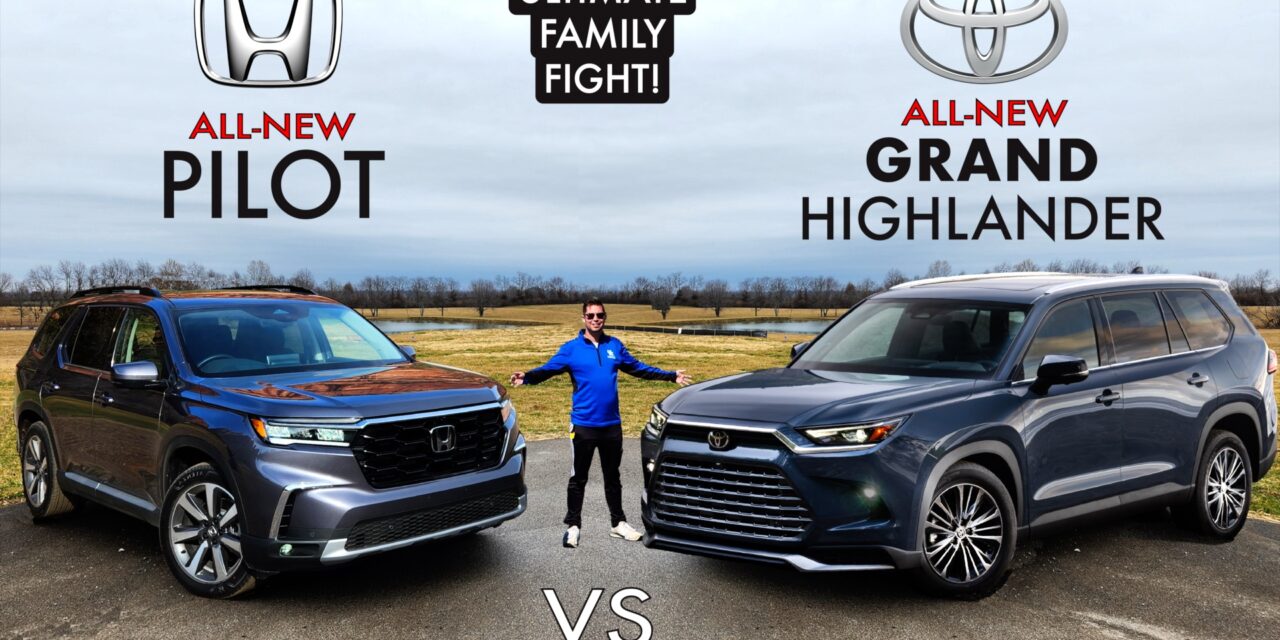
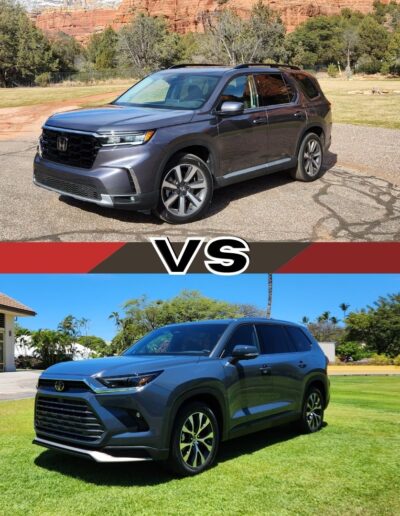
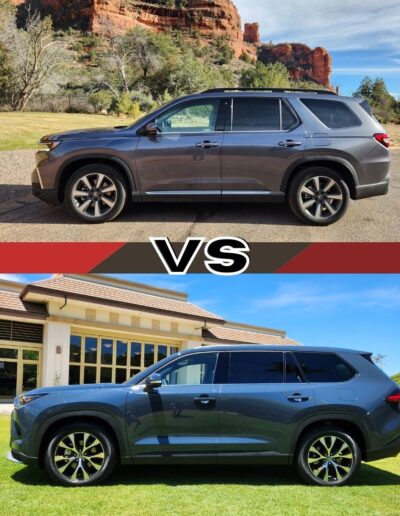
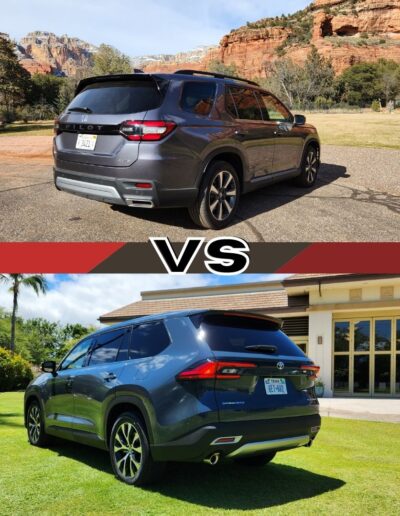
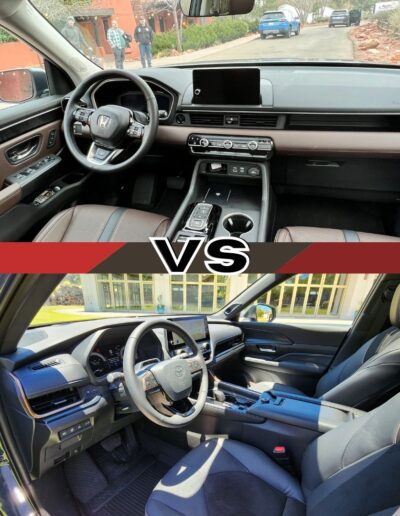
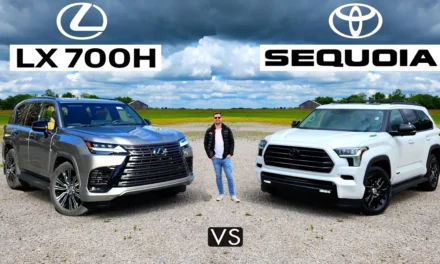
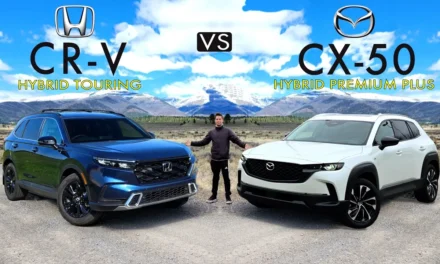
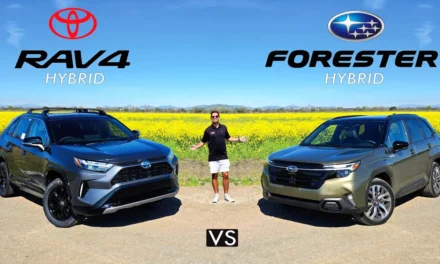







Recent Comments